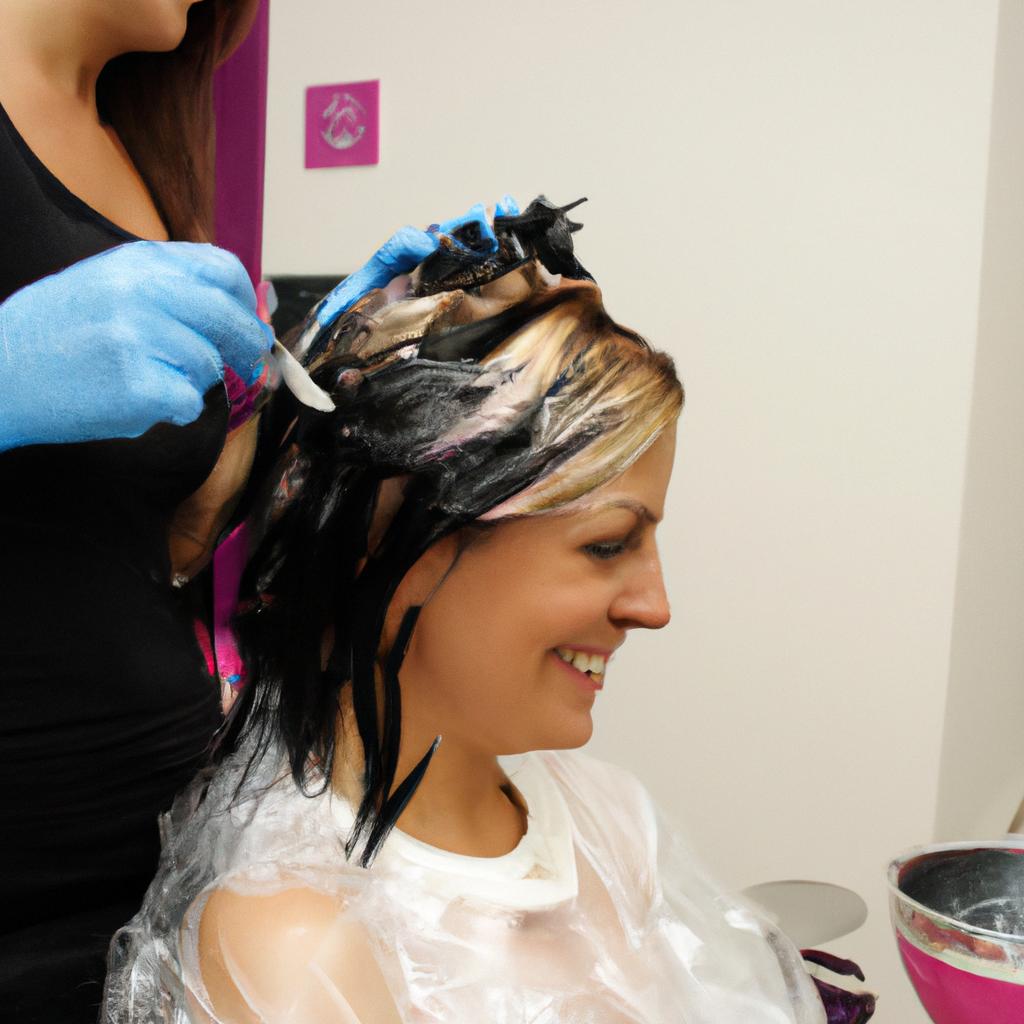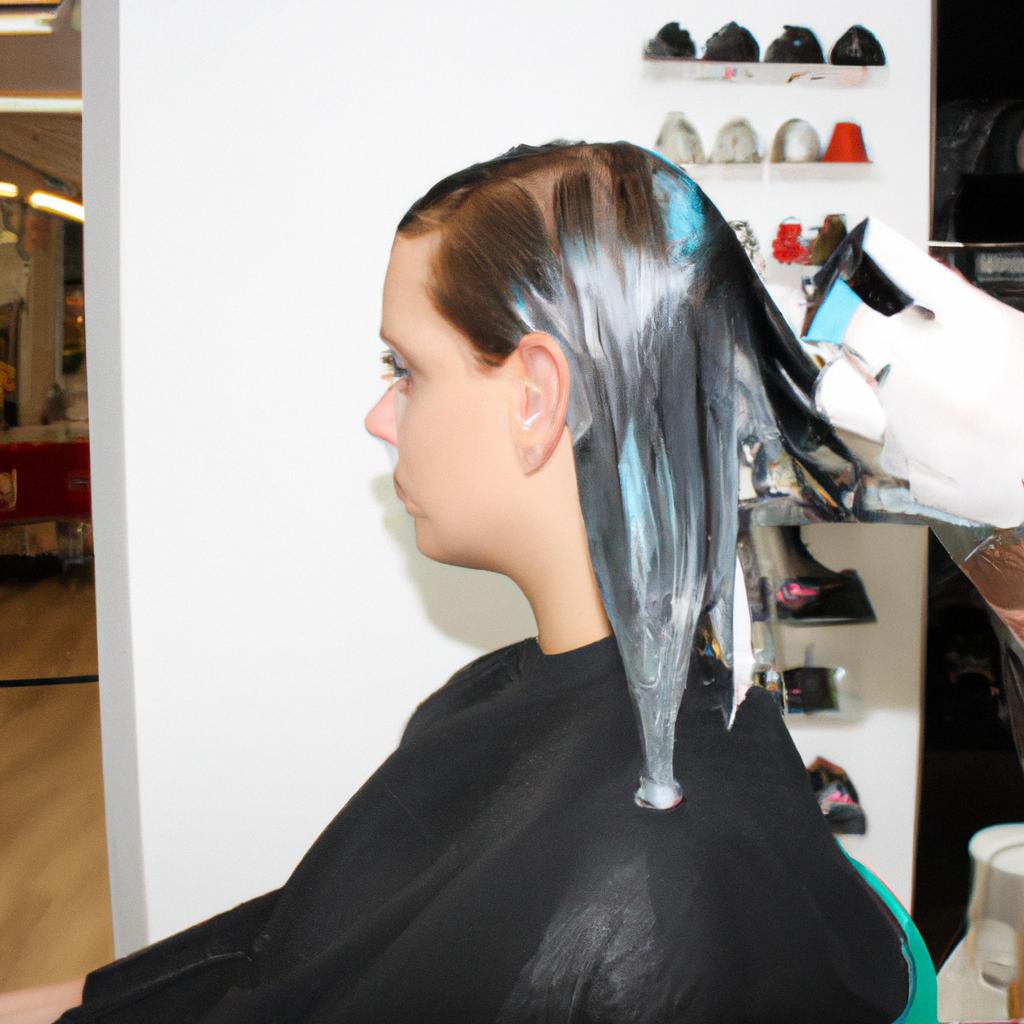Foiling in hairdressing salons has become an essential technique for mastering coloring techniques. By strategically placing foils on selected strands of hair, hairstylists are able to create dynamic and multi-dimensional color effects that enhance the overall appearance of their clients’ hair. For instance, imagine a client with dull and lifeless brown hair who desires a vibrant and sun-kissed look. Through the skilled use of foiling techniques, a professional hairstylist can transform this client’s hair by adding highlights and lowlights that mimic natural sunlight, resulting in a radiant and refreshed appearance.
The artistry behind foiling lies in its ability to customize the color placement according to each individual client’s desired outcome. This process involves sectioning off specific portions of the hair using foil strips as barriers, allowing for precise application of different colors or shades. Whether it is creating subtle dimension through fine babylights or achieving bold contrasts with chunkier highlights, foiling provides endless possibilities for creative expression in hair coloring. Furthermore, mastering this technique requires not only technical proficiency but also an understanding of color theory and knowledge of how different hues interact with one another. With these skills combined, hairstylists are empowered to unleash their creativity and offer clients personalized transformations that complement their unique features and style.
Foiling in hairdressing salons is not limited to just adding highlights and lowlights. Hairstylists can also use foils to create other effects such as ombré or balayage techniques. Ombré involves transitioning from a darker shade at the roots to a lighter shade towards the ends of the hair, creating a gradient effect. Balayage, on the other hand, involves hand-painting color onto specific sections of the hair for a more natural and blended look.
In addition to enhancing the appearance of clients’ hair, foiling techniques can also help achieve specific goals such as camouflaging gray hairs or correcting previous color mistakes. By strategically placing foils and applying the appropriate colors or toners, hairstylists can effectively address these concerns and provide clients with a flawless result.
It is important to note that while foiling can produce stunning results, it requires skillful execution and attention to detail. Proper sectioning, precise application of color products, and careful monitoring of processing times are crucial for achieving desired outcomes without damaging the hair. Therefore, it is recommended that individuals seeking foiling services consult with professional hairstylists who have undergone extensive training in this technique.
Overall, foiling has become an indispensable tool in modern hairdressing salons for its ability to transform dull hair into vibrant masterpieces. With creativity, technical expertise, and an understanding of each client’s unique needs, hairstylists can use foiling techniques to bring out the best in their clients’ hair and boost their self-confidence through personalized transformations.
Understanding Foiling Technique
Imagine a client walking into a hairdressing salon, yearning for a vibrant change in their appearance. As the stylist assesses the client’s needs and desires, they consider various coloring techniques to achieve the desired outcome. One such technique is foiling, which involves applying color or highlights using aluminum foil. This section aims to provide an in-depth understanding of the foiling technique and its significance in modern hairdressing.
Foiling offers hairstylists unparalleled control and precision when it comes to creating dimension and depth in hair color. By strategically placing sections of hair within sheets of foil, stylists can isolate specific areas for targeted color application. This method allows for seamless blending or stark contrast between different shades, resulting in visually captivating hairstyles that suit each individual’s unique features.
To fully grasp the impact and versatility of foiling, let us explore some key advantages:
- Enhanced customization: Unlike traditional methods like cap highlighting, foiling enables precise placement of color on selected strands or sections of hair.
- Seamless blend: With careful execution, a skilled stylist can seamlessly blend multiple colors throughout the client’s hair, achieving natural-looking gradients.
- Longer-lasting results: The use of foils helps protect treated sections from overlapping with other colors during processing, ensuring more defined results that last longer.
- Versatility across styles: Whether aiming for sun-kissed highlights or bold streaks of vivid hues, foiling accommodates various coloring preferences while maintaining professional standards.
In addition to these benefits, it is helpful to understand how different types of foils contribute to achieving desired outcomes. Consider the following table as a reference guide:
| Type | Description | Best Suited For |
|---|---|---|
| Traditional | Standard aluminum foil available at salons | All hair types |
| Pre-cut | Convenient pre-cut sheets | Time-sensitive clients |
| Pop-up | Interleaved sheets in a dispenser box | Busy salons |
| Colored | Foils with colored backing for visual effect | Dramatic color changes |
By familiarizing oneself with the various types of foils and their applications, stylists can confidently choose the most suitable option for each client’s desired look.
Transitioning seamlessly into the subsequent section about “Choosing the Right Foils,” this understanding of foiling technique lays the foundation for exploring how to select appropriate foils based on hair type, coloring goals, and personal preferences. Through this comprehensive approach, hairstylists can master the art of foiling, enhancing their skills in delivering exquisite transformations that leave clients feeling confident and satisfied.
Choosing the Right Foils
Building on our understanding of the foiling technique, let’s now explore the importance of choosing the right foils for achieving optimal results in hair coloring.
Section H2: Choosing the Right Foils
When it comes to selecting foils for hair coloring, there are several factors to consider. The choice of foil can greatly impact the outcome of your color application and overall client satisfaction. Let’s take a look at an example scenario to illustrate this point:
Imagine you have a client with dark brown hair who desires caramel highlights. To achieve this desired effect, you decide to use a balayage technique with foils. In this case, using traditional silver aluminum foils might not be ideal. Instead, opt for colored or translucent foils that allow you to monitor the lightening process more accurately.
To help guide your decision-making process when choosing foils, here are some key considerations:
- Material: Foils made from aluminum or plastic-coated paper offer different advantages. Aluminum provides better heat conductivity, while plastic-coated paper is gentler on the hair.
- Size: Foil sizes range from narrow strips to wider sheets. Consider both the desired end result and the length of your client’s hair when selecting foil size.
- Thickness: Thicker foils tend to retain heat longer, which may accelerate processing time. Thinner foils provide more flexibility but may require additional insulation.
- Color and transparency: Colored or translucent foils enable precise monitoring during development stages without having to constantly open them up.
By carefully considering these factors and tailoring your foil selection according to specific client needs, you can enhance control over color placement and improve overall results.
| Factors | Advantages |
|---|---|
| Material | – Aluminum offers better heat conductivity- Plastic-coated paper is gentler on the hair |
| Size | – Narrow strips for detailed placement- Wider sheets for broader highlights |
| Thickness | – Thicker foils retain heat longer for faster processing- Thinner foils provide more flexibility |
| Color and transparency | – Colored or translucent foils allow precise monitoring without constant opening |
In summary, choosing the right foils is crucial in achieving desired hair coloring results. By considering factors such as material, size, thickness, and color transparency, you can make informed decisions that optimize your technique and enhance client satisfaction.
Now that we understand the importance of selecting appropriate foils to achieve optimal results, let’s move on to preparing the hair for the foiling process.
Preparing the Hair for Foiling
Section H2: Preparing the Hair for Foiling
Transitioning smoothly from the previous section on choosing the right foils, we now move on to an equally crucial step in achieving flawless results when it comes to hair foiling – preparing the hair. To illustrate its significance, let’s consider a hypothetical scenario where a client with thick, long hair desires vibrant highlights that complement their complexion and personal style.
The first step in preparing the hair for foiling is ensuring that it is clean and dry. This helps create a smooth canvas for applying color and prevents any interference between product absorption and excess moisture. By washing the hair prior to foiling, we eliminate any unwanted residue or buildup that could affect color application. Additionally, drying the hair thoroughly enables better control during the process, allowing stylists to work efficiently without compromising precision.
Once the hair is clean and dry, attention should be given to sectioning it properly. Dividing the hair into manageable sections ensures even distribution of color while minimizing tangles or knots. The key here lies in creating consistent partings that match the desired end result. For instance, if our hypothetical client wishes to achieve natural-looking sun-kissed highlights throughout their mane, dividing the hair into smaller sections will allow for more precise placement of each foil.
To further enhance efficiency and accuracy during application, using clips or separators can be immensely helpful. These tools assist in isolating specific areas while preventing overlap or accidental mixing of colors. Moreover, they aid in maintaining organization throughout the process by keeping track of which sections have already been worked on. By utilizing such techniques alongside proper sectioning methods, stylists can ensure a seamless flow during coloring sessions.
In summary:
- Clean and dry the hair before beginning the foiling process.
- Section the hair appropriately based on desired end result.
- Utilize clips or separators to maintain organization and prevent color overlap.
By adhering to these preparatory steps diligently, hairdressers can set the stage for successful foiling, laying the groundwork for stunning color transformations. With our hypothetical scenario in mind, let’s delve into the subsequent section on applying the foils, where we will explore the techniques that bring these vibrant highlights to life.
Applying the Foils
Section H2: Applying the Foils
After properly preparing the hair for foiling, it is crucial to apply the foils correctly in order to achieve desired results. Let’s take a look at an example scenario where proper foil application plays a significant role:
Imagine a client with long, dark brown hair who desires caramel highlights. To create these highlights, sections of the hair need to be carefully selected and isolated using foils. The stylist must ensure that each section of hair is evenly distributed within the foil to avoid uneven color distribution.
When applying foils, there are several key considerations to keep in mind:
- Placement: Determining how close or far apart the foils should be placed from one another will depend on factors such as desired end result and natural hair color.
- Section size: The size of each section being colored can greatly impact the final outcome. Smaller sections may result in more precise highlighting, while larger sections can produce a softer effect.
- Tension: Maintaining consistent tension when securing the foil ensures even saturation throughout the highlighted area. Proper tension also prevents bleeding or smudging of color onto adjacent strands.
- Technique: Different techniques can be employed based on individual preferences and desired effects. Popular techniques include slicing (applying color directly across a section) and weaving (selectively choosing strands for coloring).
To further illustrate these considerations, let’s examine them in table format:
| Consideration | Importance |
|---|---|
| Placement | Crucial |
| Section size | Influential |
| Tension | Essential |
| Technique | Varied |
By understanding and implementing these aspects during the application process, stylists can enhance their skillset and master their coloring techniques.
Moving forward into our next section about “Developing the Color,” it is important to note that applying the foils correctly lays the foundation for achieving optimal results. By paying attention to details like placement, section size, tension, and technique, hairdressers can ensure a consistent and appealing outcome.
Developing the Color
Section H2: Developing the Color
Once the foils have been applied, it is crucial to allow sufficient time for the color to develop. This stage of the process is essential in achieving desired results and creating stunning hair transformations.
For instance, consider a client who wants to add subtle highlights to their dark brown hair. After applying the foils strategically throughout the hair, it is important to let the color develop for approximately 30 minutes. During this time, the chemical reaction between the coloring agent and the hair’s natural pigments takes place, resulting in a beautiful blend of colors.
To ensure optimum development of color, here are some key factors to keep in mind:
- Timing: Each individual’s hair may react differently to color treatments. It is vital to monitor the processing time carefully according to the specific brand and type of dye used.
- Temperature: The ideal temperature can vary depending on personal preferences and product instructions. However, maintaining a consistent warmth by using heat lamps or thermal caps can accelerate color development.
- Hair thickness: Thicker hair tends to take longer for color development compared to finer strands. Adjusting processing times accordingly will help achieve even results.
- Desired outcome: Different shades require varying amounts of time for optimal results. Consideration should be given not only to developing lighter tones but also ensuring enough depth for darker shades.
Table – Factors Affecting Color Development Time:
| Factor | Effect on Color Development |
|---|---|
| Timing | Varies based on individuals |
| Temperature | Accelerates development |
| Hair Thickness | Longer duration needed |
| Desired Outcome | Tailored processing time |
By taking these factors into account during each client’s unique situation, you can confidently guide them toward their desired result while providing exceptional service.
Transition sentence into subsequent section about “Finishing and Styling the Hair”:
With beautifully developed color achieved through meticulous attention to detail, the next step is to focus on finishing and styling the hair.
Finishing and Styling the Hair
Section H2: Finishing and Styling the Hair
Transitioning from the previous section, where we discussed developing the color, it is now crucial to focus on finishing and styling techniques that will enhance the overall look of foiled hair. To illustrate this further, let’s consider a hypothetical scenario where a client has just had their hair colored with foil highlights. Now, it is time to complete the transformation by applying appropriate finishing touches.
When it comes to finishing foiled hair, attention should be given to creating seamless blends between the highlighted sections and the natural base color. This can be achieved through careful toning or glazing techniques. By selecting an appropriate toner shade or using a glossing agent, stylists can neutralize any unwanted brassy tones and create a cohesive appearance throughout the hair. Additionally, employing smoothing serums or oils can provide extra shine and polish to the finished style.
To ensure optimal results in styling foiled hair after coloring, here are some essential tips:
- Use heat protectant products before applying any heat-styling tools.
- Opt for low heat settings when using curling irons or straighteners to avoid excessive damage.
- Experiment with different texturizing products such as sea salt sprays or volumizing mousses to add dimension.
- Finish off with a long-lasting hairspray to set the style in place throughout the day.
By incorporating these key steps into your salon routine, you can elevate your clients’ satisfaction levels while showcasing your expertise as a skilled hairstylist.
In addition to these practical guidelines, let us explore how completing foiling techniques successfully contributes not only to enhanced aesthetics but also impacts individuals emotionally:
| Emotional Effect | Examples |
|---|---|
| Confidence | Clients feel more confident |
| Satisfaction | Positive feedback received |
| Self-expression | Unique styles reflect identity |
| Excitement | Transformations bring joy |
This table demonstrates how foiling techniques, when executed effectively, can impact clients on an emotional level. By understanding and tapping into these emotions, hairdressers can cultivate a deeper connection with their clientele.
In summary, finishing and styling the hair after applying foil highlights is crucial to achieving a flawless result. Through careful toning, attention to detail in styling techniques, and considering the emotional impact of our work, we can create not just beautiful hairstyles but also memorable experiences for our clients.




